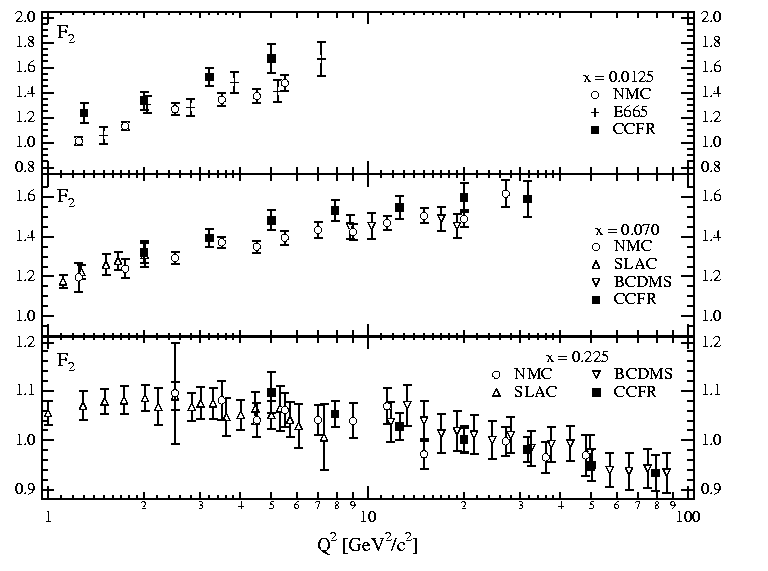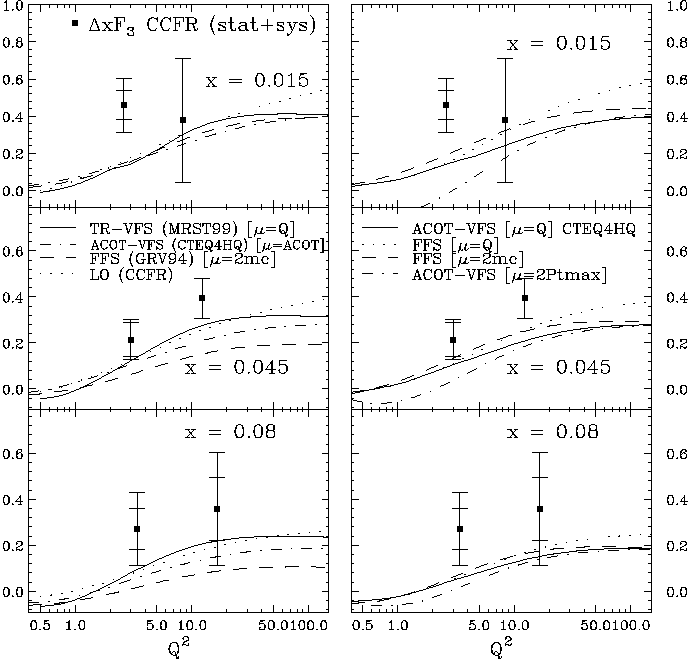
The figure below (from Seligman,
et al.) compares Neutral Current (NC) muon data from NMC and
E665 experiments with Charged Current (CC) neutrino data from CCFR.
Note that for the smallest x values (x=0.0125), the Charged Current (CC)
data (filled squares) are above the Neutral Current (NC) data (open symbols).

A new analysis (by Yang
et al.) performed the extraction of the structure functions in
a physics model independent (PMI) manner. The extracted PMI values for
Charged Current F2 neutrino are then compared with Neutral Current F2 muon/electron
within the framework of NLO models for massive charm production; these
are found to be in general agreement, thus resolving the long-standing
discrepancy between the two sets of data.

The figure above (from Yang et al.) shows F2 neutrino physics model independent (PMI) data divided by the predictions of TR-VFS (MRST99) with target mass and higher twist corrections; (right) The ratio of the previous F2 neutrino physics model dependent (PMD) data and the predictions of MRSR2. Also shown are the ratios of the F2 muon (NMC, BCDMS) and F2 electron (SLAC) to the theoretical predictions.
(Note: a comparison of F2 from neutrino DIS to that from charged lepton DIS shows good agreement above x=0.0125, but shows differences at smaller x. This low x discrepancy can be explained by the different behavior of F2 from neutrino DIS to that from muon/electron DIS as Q goes to zero. Cf., Fleming et al., for details.)
The first measurements of Delta-xF3 are systematically higher than current
theoretical predictions. Kretzer
et al., investigates the sensitivity of these theoretical
predictions upon a variety of factors including: renormalization scheme
and scale, quark mass effects, higher twist, isospin violation, and PDF
uncertainties. However, the conclusion is that it is difficult to
shift the theoretical precisions in the small Q region by the amount needed
to bring the theory in line with the central values of the data.

As the situation stands now, this Delta-xF3 puzzle poses an important challenge to our understanding of QCD and the related nuclear processes in an important kinematic region. The resolution of this puzzle is important for future data analysis, and the solution is sure to be enlightening, and allow us to expand the applicable regime of the QCD theory.
SOME RECENT EXPERIMENTAL MEASUREMENTS FROM HERA.
Measurement of Neutral
and Charged Current Cross Sections in Electron-Proton Collisions at High
Q^2
H1 Collaboration, C.Adloff, et al.
Measurement
of the Proton Structure Function F_2 at Very Low Q^2 at HERA
ZEUS Collaboration; J. Breitweg
et al.
DESY 00-071 (May 2000)
Physics Letters B 487 (2000) 1-2, 53-73
IMPROVED DETERMINATION
OF ALPHA(S) FROM NEUTRINO NUCLEON SCATTERING.
By W.G. Seligman, et al.
Phys.Rev.Lett.79:1213-1216,1997
RECENT STRUCTURE FUNCTION
RESULTS FROM NEUTRINO SCATTERING AT FERMILAB.
By CCFR / NuTeV Collaboration (U.K. Yang et al.). e-Print Archive:
hep-ex/0010001
A FIRST MEASUREMENT OF
LOW X LOW Q**2 STRUCTURE FUNCTIONS IN NEUTRINO SCATTERING.
By CCFR Collaboration and NuTeV Collaboration (B.T. Fleming et al.).
Nov 2000. 5pp.
e-Print Archive: hep-ex/0011094. Submitted to Phys.Rev.Lett.
PREDICTIONS FOR NEUTRINO
STRUCTURE FUNCTIONS.
By S. Kretzer, F.I. Olness, R.J. Scalise, R.S. Thorne, U.K. Yang.
e-Print Archive: hep-ph/0101088